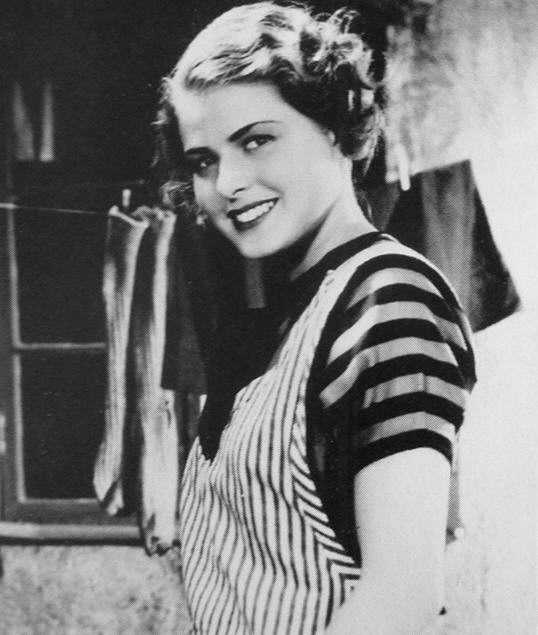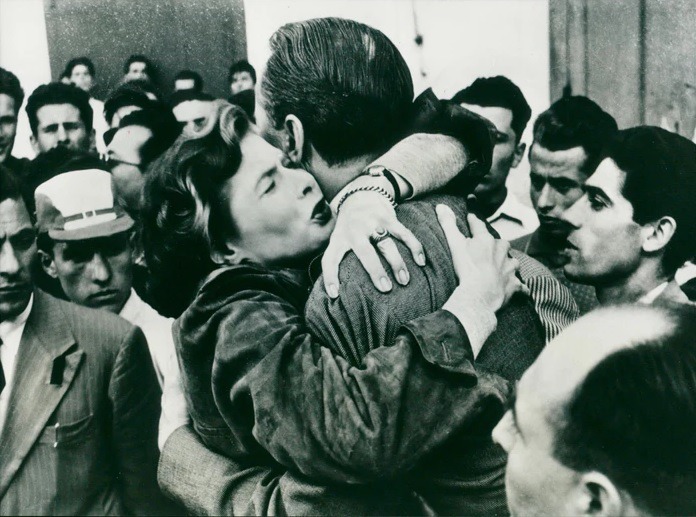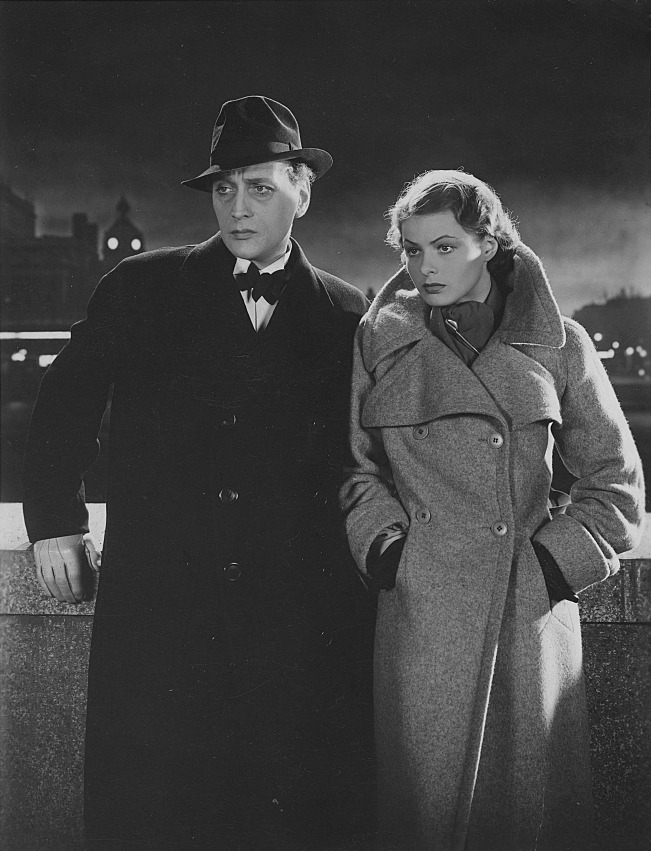Ingrid Bergman was an international icon of the 1950s whose talent knew no borders. She wasn’t just another star in Hollywood’s golden era; she redefined acting with her authenticity and emotional depth, capturing hearts from her roles in ‘Casablanca’ to her groundbreaking work with Roberto Rossellini in Italy. But beyond her on-screen magic lies a story of resilience, controversy, and a relentless pursuit of artistic freedom that shook the very foundations of the film industry. It’s a tale that touches on more than just her cinematic achievements, hinting at a life filled with personal battles, love, and a quest for identity. So, what’s behind the curtain of Bergman’s illustrious career?
Key Takeaways
- Bergman’s role in ‘Casablanca’ alongside Humphrey Bogart cemented her as a global star in the 1950s.
- She won three Academy Awards for Best Actress during this era, showcasing her exceptional talent.
- Her performances in ‘Stromboli’ and ‘Viaggio in Italia’ highlighted her versatility and range as an actress.
- Bergman’s collaboration with Roberto Rossellini marked a significant artistic evolution, influencing cinema beyond the 1950s.
- Her return to Hollywood defied scandal, with mature roles that solidified her status as an international icon.
Early Life
Born in Stockholm on August 29, 1915, Ingrid Bergman entered the world of acting at a remarkably young age, setting the stage for her future stardom. After the early loss of her parents, Bergman’s passion for acting led her to the prestigious Royal Dramatic Theatre School in Stockholm. It’s there that she honed her craft, preparing for a career that would soon take her far beyond Swedish cinema.
Her early roles in Swedish films, including ‘Munkbrogreven’ (1935) and ‘A Woman’s Face’ (1938), showcased her natural talent and versatility. These performances didn’t just catch the eye of Swedish audiences; they laid the groundwork for her international acclaim. It’s within these early Swedish films that Bergman’s career began to take shape, hinting at the global superstar she was destined to become.
Though still years away from her Hollywood breakthrough, Bergman’s acting in these foundational roles demonstrated a depth and presence rare in the industry. Her early experiences in Swedish cinema, combined with her studies at the Royal Dramatic Theatre, equipped her with the skills she needed to captivate audiences worldwide, marking the beginning of her journey to becoming an international star.
Hollywood Breakthrough
How did Ingrid Bergman’s role in the iconic film ‘Casablanca’ in 1942 catapult her to international stardom? It wasn’t just the misty air of romance or the timeless lines. It was Bergman’s undeniable talent and on-screen chemistry with Humphrey Bogart that won hearts worldwide. Her portrayal in ‘Casablanca’ earned critical acclaim, positioning her as a leading actress in Hollywood.
Bergman’s breakthrough didn’t stop there. She went on to dazzle audiences in ‘Gaslight’ and ‘Notorious,’ films that showcased her incredible versatility. These roles weren’t just performances; they were proof of her ability to captivate and convey complex emotions, earning her three Academy Awards for Best Actress. Each character she played added layers to her growing reputation as a celebrated talent.
Her success in these films solidified her status as an international star. Bergman wasn’t just a Hollywood phenomenon; she was a global icon. Her journey from ‘Casablanca’ to becoming a household name is a demonstration of her talent, versatility, and the enduring impact of her work. Bergman’s Hollywood breakthrough in the 1940s and 1950s was a pivotal moment, marking her as an unforgettable figure in cinema history.
Iconic Film Roles
In the 1950s, Ingrid Bergman’s roles showcased her versatility and solidified her as a cinematic icon. Her acclaimed performance in ‘Stromboli’ (1950), directed by Roberto Rossellini, marked a significant turning point. You’ll see her emotional depth and range come to life in ‘Viaggio in Italia’ (1954), also known as ‘Journey to Italy’. This role, among others, showcases her ability to convey complex emotions with subtlety and power.
Bergman’s portrayal of a Holocaust survivor in ‘Europe ’51’ (1952) further highlighted her willingness to tackle challenging and complex characters, demonstrating her exceptional acting prowess. Then came ‘Anastasia’ (1956), where she earned an Academy Award for Best Actress. Her portrayal of the titular character is nothing short of iconic, blending strength and vulnerability in a memorable performance.
Lastly, her role in ‘Indiscreet’ (1958) opposite Cary Grant, further cemented her status as an international cinematic icon of the 1950s. Her chemistry with Grant is undeniable, making it a standout in her illustrious career. Through these roles, Ingrid Bergman not only showcased her versatility but also left an indelible mark on the film industry, becoming a true icon of her time.
Italian Film Era
Shifting focus to the Italian Film Era, you’ll find Ingrid Bergman’s collaboration with Roberto Rossellini dramatically reshaped her career trajectory. Diving into Italian cinema, she starred in seven films under Rossellini’s direction, a bold move that not only showcased her acting depth but also her fearless pursuit of artistic exploration.
Their first project together, ‘Stromboli,’ ignited a Hollywood scandal. The controversy surrounding her relationship with Rossellini during the film’s production temporarily marred her image. Yet, this period was far from a downfall. Instead, it marked a transformative phase, cementing Bergman’s status as an international icon. Her ventures into Italian cinema, despite the initial backlash, earned her critical acclaim. Bergman’s willingness to immerse herself in different cinematic styles and cultures highlighted her exceptional adaptability and international appeal.
This era in Bergman’s life wasn’t just about changing geographical locations or cinematic genres. It was about embracing change, taking risks, and breaking new ground. Her work with Rossellini wasn’t just a chapter in her career; it was a reflection of her enduring legacy and a bold statement in the history of film.
Hollywood Return
After her bold foray into Italian cinema, Bergman made a celebrated return to Hollywood, defying the scandal that once threatened her career. You’ve heard about her scandalous affair with Roberto Rossellini, the one that got her banned from Hollywood. Yet, she didn’t let that define her. Instead, she transformed her image, taking on mature roles in films like ‘Anastasia,’ ‘Indiscreet,’ and ‘Goodbye Again.’ These weren’t just any roles; they showcased her versatility and acting prowess, proving her critics wrong.
Finding her footing in Hollywood wasn’t easy, especially after the scandal. Despite the challenges, Bergman’s performances were deeply emotional, resonating with audiences worldwide. She didn’t stop at films either. You’ve seen her on television and in theater, expanding her artistic horizons and cementing her status as an international icon.
Personal Life
Exploring her personal life reveals how Ingrid Bergman’s off-screen experiences deeply influenced her career and public image. Married three times, her most controversial relationship was with director Roberto Rossellini in the 1950s. This scandalous affair shocked the world, yet it shaped her legacy as an international icon of the era. Together, they had children, including actress Isabella Rossellini, cementing a lineage of grace and talent.
Bergman’s elegance wasn’t confined to the silver screen; it permeated her personal life, even as she faced challenges. Battling breast cancer in the 1970s, she continued to pursue her acting career, demonstrating incredible resilience and dedication. Her struggle with the disease, alongside her professional achievements, left an indelible mark on her legacy.
Despite the backlash from her affair with Rossellini, Bergman’s personal life, filled with both joy and turmoil, was integral to her identity. It influenced her professional choices and contributed to her status as a revered figure. Ingrid Bergman’s journey, marked by scandal, resilience, and unwavering elegance, is a testimony to her enduring grace and impact as an international icon of the 1950s.
Acting Style
You’ve seen Ingrid Bergman shine on screen, but have you ever wondered what made her performances so enchanting? Her secret lies in a masterful blend of naturalistic performance and an unparalleled ability to express a wide range of emotions. This unique combination not only set her apart but also defined her as a timeless icon in the world of cinema.
Naturalistic Performance Approach
Ingrid Bergman stood out in the 1950s for her naturalistic acting style, bringing characters to life with authenticity and deep emotional connection. She harnessed sincerity and authenticity, making every performance resonate with viewers. By focusing on subtle gestures and emotions, she forged a genuine connection with her audience, setting her apart as a mesmerizing and versatile actress. Bergman’s immersive acting was rooted in her personal experiences, lending depth to her portrayals. This approach didn’t just display her talent; it showcased her as a pioneering force in cinema. Her knack for conveying complex emotions through simplicity and depth cemented her status as an iconic figure of her era, admired for her naturalistic performance approach.
Emotional Range Mastery
Bergman’s acting style, marked by an impressive emotional range, set her performances apart in cinema’s golden age. Her mastery is vividly showcased through:
- Gaslight: A descent into madness, displaying Bergman’s ability to evoke powerful emotions.
- Notorious: Her portrayal of vulnerability and conflict, highlighted by subtle gestures.
- Casablanca: Longing and heartbreak communicated through her expressive eyes.
- Joan of Arc at the Stake: Demonstrating depth and authenticity, evoking a strong emotional response.
- Anastasia and Autumn Sonata: A tribute to her emotional versatility, from strength and resilience to vulnerability and despair.
Bergman’s talent in conveying complex emotions with authenticity made her a timeless icon, enchanting audiences worldwide.
Legacy and Honors
Reflecting on her remarkable contributions to the arts, Ingrid Bergman’s legacy continues to shine brightly in the world of international cinema, earning her posthumous honors and widespread acclaim. In 2015, the Cannes Film Festival paid tribute to Bergman, highlighting her lasting impact on the film industry. It’s a tribute to her status as an international icon, showcasing how her work has transcended generations.
A documentary, ‘Ingrid Bergman: In Her Own Words’, premiered at the festival, offering an intimate look at her life and career. This film not only celebrated her achievements but also cemented her global recognition. It’s a powerful reminder of her enduring popularity, which even today, captivates audiences around the world.
In 2013, a signed portrait of Bergman was auctioned, further proving her influence and legacy within the industry. Her contributions have solidified her place as a true icon of the 1950s, renowned for her talent and timeless performances. Bergman’s impact is undeniable, and her legacy continues to be celebrated globally, ensuring her place in the annals of cinematic history.
Final Years
During her final years, she continued to captivate audiences with her performances, earning critical acclaim and an Emmy award. She shone brightly in roles that spanned from the complex emotions of ‘Autumn Sonata’ to the formidable character of Israeli Prime Minister Golda Meir in ‘A Woman Called Golda.’ Her portrayal in the latter won her an Emmy, highlighting her exceptional talent and versatility. Despite facing health challenges, she didn’t let anything diminish her passion for acting. She even extended her illustrious career to the stage, taking on roles like in ‘The Constant Wife,’ proving her dedication to her craft.
To help you enjoy what’s written, consider these points:
- Bergman’s final performances in Autumn Sonata and “A Woman Called Golda” received widespread critical acclaim.
- Her Emmy win for portraying Golda Meir showcased her acting range.
- She received her seventh Academy Award nomination for her role in Autumn Sonata
- Despite health challenges, her dedication to her craft never wavered, extending to a vibrant stage career.
- Bergman’s legacy and posthumous honors, including tributes at the Cannes Film Festival, continue to celebrate her contribution to cinema.
Frequently Asked Questions
What Was Ingrid Bergman Most Famous For?
She’s best known for her role as Ilsa Lund in ‘Casablanca.’ Her performances in ‘Gaslight,’ ‘Notorious,’ and ‘Anastasia’ also earned her critical acclaim and international recognition.
What Movie Did Ingrid Bergman Win an Oscar For?
She clinched the Oscar for Best Actress with her role in ‘Anastasia’ in 1957, marking a significant win in her illustrious career.
What Italian Director Did Ingrid Bergman One of the Most Important Screen Figures in Cinematic History Have a Relationship With?
She had a relationship with director Roberto Rossellini. They worked on seven films together, greatly impacting her career and life in the 1950s.
Conclusion
Ingrid Bergman truly stands as a towering figure in the world of cinema. With her raw talent and emotional depth, she captivated audiences around the globe. From Hollywood classics to Italian masterpieces, Bergman’s versatility knew no bounds. Her life, marked by both triumphs and challenges, only added layers to her on-screen performances. Honored with prestigious awards, her legacy is undeniable. Bergman wasn’t just an actress; she was a symbol of resilience, talent, and timeless appeal. Her impact remains unparalleled, making her an eternal icon.





